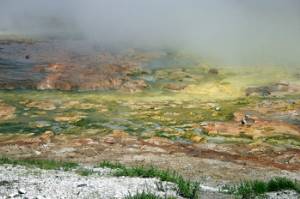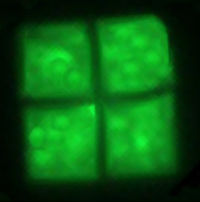Archaebacteria
Online Biology Dictionary
|
|

|
| Archaeans color a hot spring in Yellowstone N. P. |
Archaebacteria was a name formerly used to refer to a group of organisms discovered in the late 1970s and now known as the Archaea.
At the time, Carl Woese of the University of Illinois was studying relationships among the prokaryotes and had found that there were two very distinct groups, those that live at high temperatures or produce methane and those that do not. Because these two types of prokaryotes are so different at the genetic level, Woese suggested that all life be divided into three domains: Eubacteria, Archaebacteria and Eukaryota. This three-domain system of life is now widely accepted, but Woese and his colleagues later decided that the second of these terms was inappropriate, and shortened it to Archaea.
Archaea is one of two prokaryote domains, the other being Bacteria. Only the single-celled organisms assigned to the domain Bacteria are now called bacteria. The organisms in Domain Archaea, formerly also called bacteria, are now known as archaeans.

|
| Haloquadratum walsbyi |
The various microbes assigned to the two domains Archaea and Bacteria are generally similar in size, shape and appearance (although there are a few oddball archaeans, such as Haloquadratum walsbyi (see figure right), which is quite weird since its cells are shaped like flat, square boxes). Archaeans and bacteria differ markedly, however, at the genetic level. For example, they're about as distinct from each other with respect to their ribosomal RNA sequences as is either from a eukaryote (Eukaryota is the third of the three currently recognized domains of life). So archaeans, bacteria and eukaryotes are the three categories that comprise all forms of life (with the exception of viruses).
Archaea is divided into three groups on the basis of the type of environment in which each thrives: methanogens (archaeans that produce methane as a metabolic byproduct in anoxic conditions), halophiles (ones that produce methane as a metabolic byproduct in anoxic conditions), and thermophiles (ones that live at relatively high temperatures, between 41 and 122 째C).
The archaea can utilize a much broader range of energy sources than bacteria. In fact, they were initially identified as organisms that lived in extreme environments, such as hot springs or salt lakes. However, they are now known to occur in many other types of environments.
Most shared on Macroevolution.net:
Human Origins: Are we hybrids?
On the Origins of New Forms of Life
Mammalian Hybrids
Cat-rabbit Hybrids: Fact or fiction?
Famous Biologists
Dog-cow Hybrids
Georges Cuvier: A Biography
Prothero: A Rebuttal
Branches of Biology
Dog-fox Hybrids